Enviroschools West Coast recently held a Noho Marae (or sleepover) at Arahura Marae. Around 30 students and staff from Kaniere School, Hokitika Primary, Reefton Area School, Sacred Heart and St Canice’s School attended.

Learning about riparian planting zones.
The aim of the event was to learn about the cultural and natural history of the area, to build skills and knowledge for restoring native habitats and to learn about the restoration of the Arahura River.
The group gathered at the marae after school on August 10 for a pōwhiri – welcome. They learned about the traditions and protocols of the marae and wharenui. The charismatic leadership of Tihou Weepu, his mother Ema Weepu and Raven Whatu-Joseph was inspirational. Zoe Watson and Sarah Harvey from Enviroschools West Coast were instrumental in making the event run like clockwork.
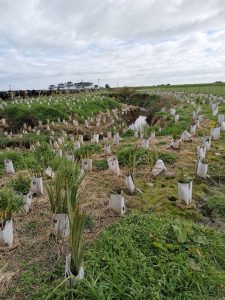
Arahura restoration planting.
Those attending were mostly first-time visitors, with the consensus being that the wharenui was an unbelievably beautiful and spiritual building. The changeable lights in the roof panels shining behind the koru patterned rafters quickly mesmerised the group. The intricately carved wall panels and stories behind them left everyone speechless.
The schools had each been assigned a local species of tree or plant to investigate prior to the event. Presentations about the plants that evening were varied and included a slide show, rap and dramatisations.
Delicious meals were supplied in the well-equipped, spacious wharekai or dining room.
Interactive games and storytelling by Tihou had everyone spellbound. This included the story of Poutini, after whom the West Coast is named. The participants nestled into their sleeping bags and reflected on the learnings to date.
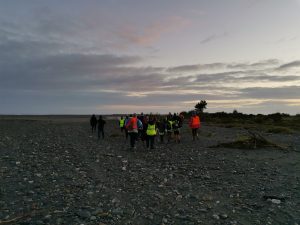
Early morning at the Arahura.
Woken bright and early to a karakia, the group then headed to the nearby Arahura river mouth to check the fish and tuna-eel traps that had been set the previous evening.
The event was well supported by Department of Conservation’s Michelle Lambert and Suze Harris, with Ms Harris sharing her expert knowledge of the marine life. The students and adults were fascinated with the tuna.
After a hearty breakfast the group was off to explore the flora in the nearby Arahura Church grounds, learning traditional Māori use of the plants from the highly knowledgeable Ema.
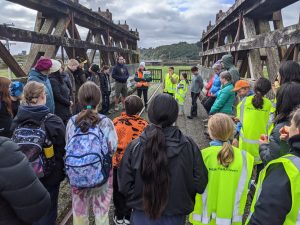
Kim talks the the group on the old bridge.
Morning tea of delicious home baking, supplied by the students and eaten on the historic Arahura bridge, followed.
The extensive riparian planting of a valley stream was then studied with the help of Kim McPherson, one of the project coordinators of the He Kākano Project. The children were given information about the restoration including the elements in cow manure: phosphorous, potassium and nitrogen, and the role these played in plant growth.
Returning to the marae, the students learned to spot native seedlings in the bush and how to transplant them successfully.

Raven carefully removes a seedling for transplanting to the restoration site.
Lunch was followed by a clean-up, a gathering to share learning, and a farewell.
Without a doubt, the one-and-a-half-day event was informative, extremely thought-provoking, and inspirational for all who attended. The students were abuzz with information and keen to recommend an Enviroschools Noho Marae to their classmates back at school.

Retrieving the net to check on what has been caught.
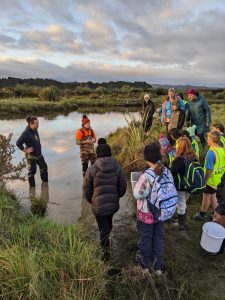
Suz and Tihou talk about life in the awa.

Isabella shows the inanga that has been captured.
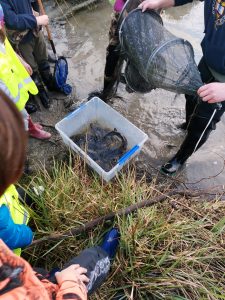
The tuna/eels are removed from the nets.

A big bully.
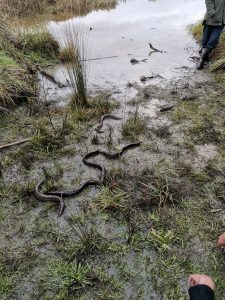
Tuna make their escape.
Enviroschools West Coast would like to thank the generous sponsors Department of Conservation and the West Coast Community Trust for supporting this event.
Thank you to West Coast Messenger for permission to use their original story here on p 7.
Banner image:

Watching the nets being recovered, from the side of the awa.
